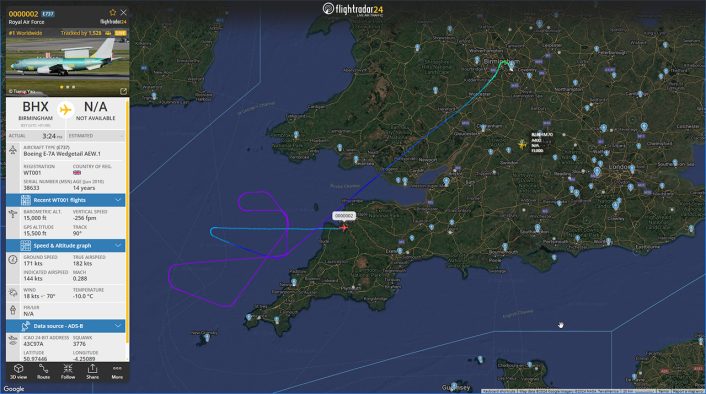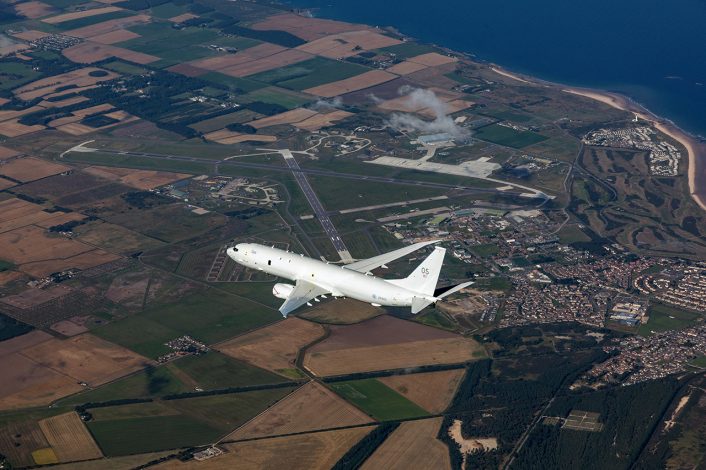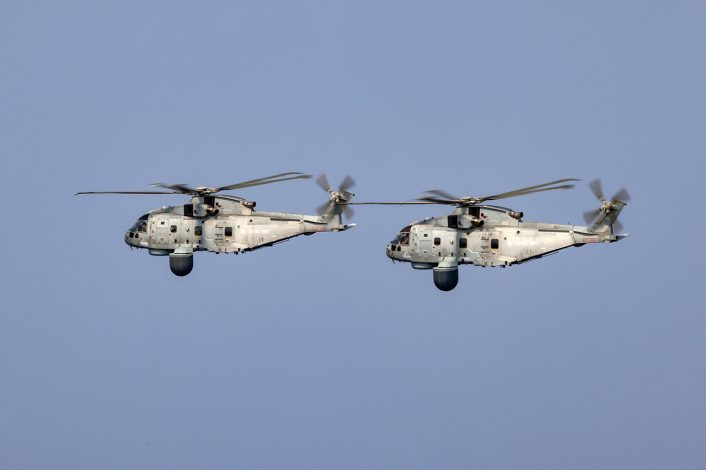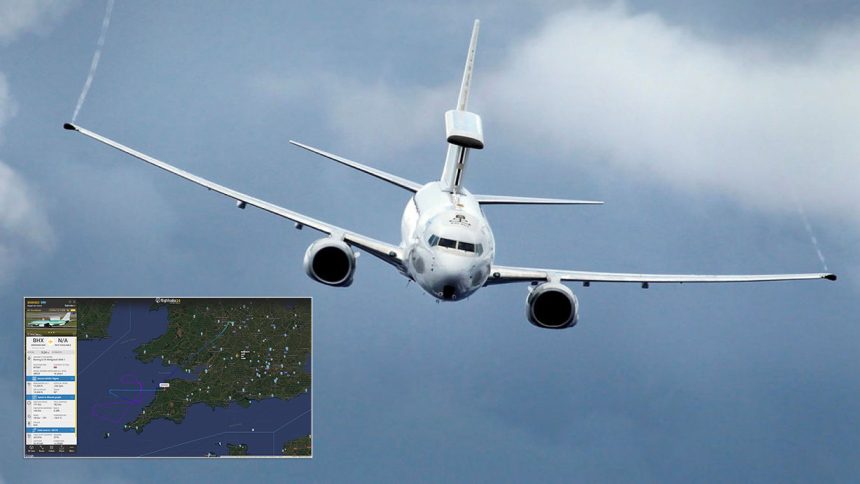The first of three Boeing E-7A Wedgetail airborne early warning aircraft ordered by the Royal Air Force completed its first test flight on Sept. 20, 2024 following conversion at Birmingham International Airport.
Carrying the UK military serial number WT001, the aircraft took off from Birmingham International Airport shortly before 14.30 UTC on Sept. 20, 2024, before travelling to airspace over the Bristol Channel to complete its test flight programme.

While this was the first flight of the airframe following its conversion to E-7 Wedgetail specification, the aircraft was actually delivered in 2010 as a Boeing 737-700 Boeing Business Jet registered N384BJ. In 2012 it was re-registered as B-5273 for use by Deer Jet, a Chinese business jet provider. Boeing acquired the aircraft in June 2019, placing it back on the US register as N946BC. It arrived in the UK for military conversion in January 2021.
The next two aircraft, which are undergoing their respective conversions at Birmingham now, will be WT002 and WT003. WT002 is around the same age as WT001 with a similar history, but WT003 is a new build airframe, having been completed in 2022. The use of second-hand aircraft allows for a quicker journey to conversion and entry to service for these airframes, avoiding the waitlist for new-builds.
The Royal Air Force initially planned to acquire five E-7s, designated Wedgetail AEW1, to replace the E-3D Sentry AEW1, though this number was cut to three aircraft in 2021. With the final E-3Ds bowing out of service in 2021, this has left the RAF without a dedicated airborne early warning aircraft for a number of years.
Thanks to a degree of commonality with the P-8A Poseidon MRA1, also based on the Boeing 737, the chosen base for the RAF Wedgetail fleet is RAF Lossiemouth in North-East Scotland. In addition to facilities constructed to support the Poseidon fleet, new facilities have been built and opened in preparation for the Wedgetail’s arrival. The Sentry fleet had previously been based at RAF Waddington in Lincolnshire.
Current hopes are for the E-7 to enter initial service with the RAF from 2025. They will be operated by 8 Squadron, which has been a dedicated AEW squadron for over fifty years. It marks a return for 8 Squadron to Lossiemouth, where they flew the Avro Shackleton AEW2 from 1973 to 1991, prior to the delivery of the E-3D Sentry and the unit’s subsequent move south to Waddington.

The UK will be the fourth nation to operate the E-7 Wedgetail, following South Korea, Turkey, and initial customer Australia. Soon to join them will be the United States and NATO, who have both selected the aircraft to replace their existing fleets of E-3 Sentry aircraft. The U.S. Air Force hopes to begin production of its aircraft from next year, with a full inventory of twenty six E-7s planned by the early 2030s. NATO has specified six aircraft, with the first to be delivered by 2031. The Geilenkirchen based fleet of E-3s would then be retired by 2035.
Capability Gaps
The term ‘capability gap’ has been a running theme in UK defence circles for many years, referring to the retirement of capabilities before their replacements are matured, or in many cases (including the Wedgetail) even delivered. In the case of the Sentry, and a number of other platforms like the Sentinel R1 and Nimrod R1, operational taskings were still being carried out days or even hours before their official retirements.
An apparent four year gap between the retirement of the E-3D fleet and the entry into service for the Wedgetail is actually a rather short one compared to most. Most notably, just over ten years separated the early withdrawal of the Nimrod MR2 maritime patrol aircraft in 2010 and the declaration of initial operating capability for the Poseidon MRA1 in April 2020. During this time, the UK could rely only on its allies for fixed wing maritime patrol operations, which is particularly remarkable given the size of the UK’s maritime interests, search and rescue zones, and its operation of a solely submarine-based nuclear deterrent.
While the array of ground based radar stations covering UK airspace, as well as the nearby location of many allied nations, means that the UK can, to a degree, manage its air defence without airborne AEW, the loss for several years of a deployable capability leaves expeditionary missions either unsupported or relying on allied forces. Some of the final operational missions for the RAF’s Sentry aircraft saw them supporting the aircraft carrier HMS Queen Elizabeth and its carrier strike group in the Mediterranean during the CSG 21 deployment. While the Merlin HM2 AEW platform fielded by the Royal Navy is a capable one for what it is, it cannot attain the altitude nor sustain the same endurance that a fixed wing platform can.

Rather ironically, when the Royal Navy initially chose to forgo its fixed wing airborne early warning aircraft, moving to STOVL carriers, Royal Air Force planners had suggested that the carriers would always be within range of an RAF fixed wing AEW platform. Faults with this plan became rapidly apparent during the Falklands War, which saw carriers operating well beyond the range of the RAF’s Shackletons and therefore without any dedicated airborne early warning at all. This spurred the development of the Sea King AEW, the modern basis of which now flies on the Royal Navy’s Merlins. The Merlin AEW, despite its long development, is expected to mostly be a stopgap measure before the introduction of unmanned AEW systems.
With the small number of Wedgetails ordered by the RAF, it is likely a positive sign that the Royal Navy has its own plans for organically provided AEW. Accounting for maintenance cycles and crew training requirements, it is unlikely that the RAF will be able to sustain more than one AEW aircraft on any prolonged overseas deployments, such as those supporting a carrier strike group. Many within the MoD will likely be hoping that a follow on order for two additional airframes, restoring the order to the original five aircraft, will be forthcoming in the future.









